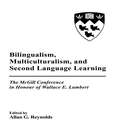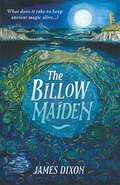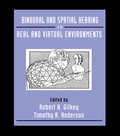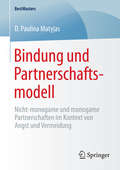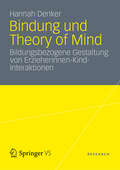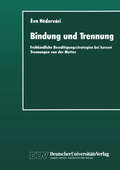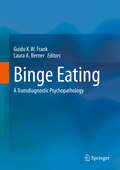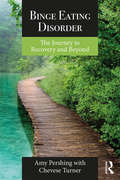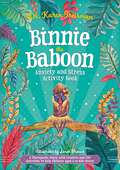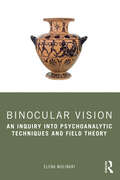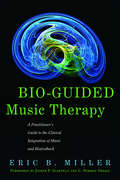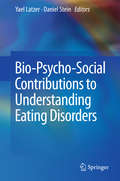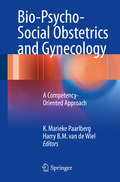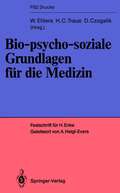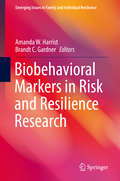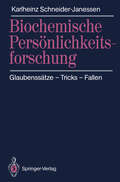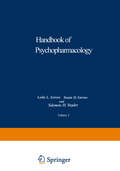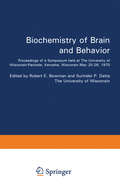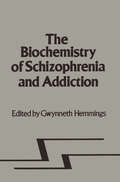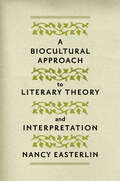- Table View
- List View
Bilingualism, Multiculturalism, and Second Language Learning: The Mcgill Conference in Honour of Wallace E. Lambert
by Allan G. ReynoldsThis collection pays tribute to Professor Wallace E. Lambert and his contributions to the fields of language and linguistics. Each chapter, written by an internationally renowned theorist or researcher, traces the currents of theory and research within the topic area to the present day, provides a state-of-the-art review of the topic, and offers an outline for future research directions. The book concludes with an overview from Professor Lambert that critically examines the impact of the ideas in each individual chapter. This volume is organized around the three areas where Professor Lambert's unique contributions are most substantial and most evident: bilingualism, multiculturalism, and second language learning. Specifically, the papers presented discuss the topics of social, psychological, cognitive, and neuropsychological aspects of bilingualism and second language learning, the psychology of inter-group relations and multiculturalism, bilingual/immersion education, and language planning. Note: Royalties earned from sales of this book will go to the Wallace E. Lambert Student Research Fund at McGill University for use by students interested in second language acquisition, bilingualism, and/or multiculturalism.
The Billow Maiden
by James DixonAilsa’s mum is ill, not the first time, so they spend the summer with her aunt and uncle. Aunt Bertha, Uncle Nod and their dog Moxie live on an island off the coast, by a beautiful fishing village surrounded by beaches and clifftops. Ailsa and Moxie spend their whole time there exploring these beaches and cliffs, until one day they find a hidden cave. Inside the cave, they find Hefring, a strange woman not keen on strangers. Ailsa slowly gets to know who Hefring is. She is a selkie, a mermaid, a billow maiden from ancient myth. However, she is stuck on land and slowly dying. It is up to Ailsa and her new friend Camilla to save her, but there are plenty of obstacles in the way – not least Ailsa’s own fears and her mum’s illness. The Billow Maiden is a beautifully told tale of friendship, family, healing and transformation from a stunning new writer for children.
Binaural and Spatial Hearing in Real and Virtual Environments
by Robert Gilkey Timothy R. AndersonThe current popular and scientific interest in virtual environments has provided a new impetus for investigating binaural and spatial hearing. However, the many intriguing phenomena of spatial hearing have long made it an exciting area of scientific inquiry. Psychophysical and physiological investigations of spatial hearing seem to be converging on common explanations of underlying mechanisms. These understandings have in turn been incorporated into sophisticated yet mathematically tractable models of binaural interaction. Thus, binaural and spatial hearing is one of the few areas in which professionals are soon likely to find adequate physiological explanations of complex psychological phenomena that can be reasonably and usefully approximated by mathematical and physical models. This volume grew out of the Conference on Binaural and Spatial Hearing, a four-day event held at Wright-Patterson Air Force Base in response to rapid developments in binaural and spatial hearing research and technology. Meant to be more than just a proceedings, it presents chapters that are longer than typical proceedings papers and contain considerably more review material, including extensive bibliographies in many cases. Arranged into topical sections, the chapters represent major thrusts in the recent literature. The authors of the first chapter in each section have been encouraged to take a broad perspective and review the current state of literature. Subsequent chapters in each section tend to be somewhat more narrowly focused, and often emphasize the authors' own work. Thus, each section provides overview, background, and current research on a particular topic. This book is significant in that it reviews the important work during the past 10 to 15 years, and provides greater breadth and depth than most of the previous works.
Binaural and Spatial Hearing in Real and Virtual Environments
by Robert H. Gilkey Timothy R. AndersonThe current popular and scientific interest in virtual environments has provided a new impetus for investigating binaural and spatial hearing. However, the many intriguing phenomena of spatial hearing have long made it an exciting area of scientific inquiry. Psychophysical and physiological investigations of spatial hearing seem to be converging on common explanations of underlying mechanisms. These understandings have in turn been incorporated into sophisticated yet mathematically tractable models of binaural interaction. Thus, binaural and spatial hearing is one of the few areas in which professionals are soon likely to find adequate physiological explanations of complex psychological phenomena that can be reasonably and usefully approximated by mathematical and physical models. This volume grew out of the Conference on Binaural and Spatial Hearing, a four-day event held at Wright-Patterson Air Force Base in response to rapid developments in binaural and spatial hearing research and technology. Meant to be more than just a proceedings, it presents chapters that are longer than typical proceedings papers and contain considerably more review material, including extensive bibliographies in many cases. Arranged into topical sections, the chapters represent major thrusts in the recent literature. The authors of the first chapter in each section have been encouraged to take a broad perspective and review the current state of literature. Subsequent chapters in each section tend to be somewhat more narrowly focused, and often emphasize the authors' own work. Thus, each section provides overview, background, and current research on a particular topic. This book is significant in that it reviews the important work during the past 10 to 15 years, and provides greater breadth and depth than most of the previous works.
Bindung und Partnerschaftsmodell: Nicht-monogame und monogame Partnerschaften im Kontext von Angst und Vermeidung (BestMasters #0)
by D. Paulina MatyjasAnhand einer empirischen Erhebung untersucht D. Paulina Matyjas die Bindungsqualität als psychischen Wirkfaktor für verschiedene Aspekte monogamer und nicht-monogamer Partnerschaftsmodelle. Den Diskurs um alternative Beziehungskonzepte erweitert die Autorin mit dieser Studie um eine persönlichkeitspsychologische Perspektive. D. Paulina Matyjas zeigt, dass das Ausmaß der Verlustangst und der Vermeidung von Nähe in einer Partnerschaft mit der persönlichen Affinität zu einem der beiden Beziehungskonzepte, dem Grad der Partnerschaftszufriedenheit in den beiden Beziehungsmodellen sowie der intrapersonellen Reaktion auf einvernehmliche sexuelle Außenkontakte des Partners variiert.
Bindung und Theory of Mind: Bildungsbezogene Gestaltung von Erzieherinnen-Kind-Interaktionen
by Hannah DenkerBindungen von Kindern zu vertrauten Bezugspersonen gelten als sozial-emotionale Grundlage ihrer Entwicklung und Bildung. Neuere Forschungen belegen den Einfluss der Qualität der Interaktionserfahrungen auf die Aneignung kultureller Symbolsysteme wie der Sprache. Vor diesem Hintergrund entwickelt Hannah Denker ein integratives Theoriemodell zum Zusammenhang von Bindung und Theory-of-Mind-Entwicklung. Sie vertritt die These, dass die affektive und kognitive kindliche Entwicklung in reziproker Beziehung zueinander stehen und über stellvertretende Deutungen (Szenen geteilter Aufmerksamkeit, Mind-Mindedness, sustained shared thinking) positiv beeinflusst werden kann. Diskutiert werden u.a. didaktische Konsequenzen für eine bildungsbezogene Gestaltung von Erzieherinnen-Kind-Beziehungen.
Bindung und Trennung: Frühkindliche Bewältigungsstrategien bei kurzen Trennungen von der Mutter
by Éva HéderváriBinge Eating: A Transdiagnostic Psychopathology
by Guido K. W. Frank Laura A. BernerThis book provides a comprehensive overview of our current understanding of binge eating, which is characterized by the uncontrollable consumption of large amounts of food in a discrete time period. Written by experts on eating disorders, it first introduces the phenotype of binge eating, including its epidemiology and assessment. It then describes the underlying neurobiological alterations, drawing on cutting-edge animal models and human studies to do so. In addition, it extensively discusses current treatment models, including medication, psychotherapy, self-interventions and disease prevention. Lastly, an outlook on the future research agenda rounds out the coverage. Given binge eating’s current status as an under-researched symptom, but one shared across many eating disorders, this book provides an up-to-date, integrative and comprehensive synthesis of recent research and offers a valuable reference for scientists and clinicians alike.
Binge Eating Disorder: The Journey to Recovery and Beyond
by Amy Pershing Chevese TurnerBinge Eating Disorder, written by a clinician and an advocate who have personally struggled with Binge Eating Disorder (BED), illuminates the experience of BED from the patient perspective while also exploring the disorder’s etiological roots and addressing the components of treatment that are necessary for long-term recovery. Accessible for both treatment providers and patients alike, this unique volume aims to explore BED treatment and recovery from both sides of the process while also providing a resource for structuring treatment and building effective interventions. This practical roadmap to understanding, resilience, and lasting change will be useful for anyone working clinically with or close to individuals suffering from BED, as well as those on the recovery journey.
Binge Eating Disorder: The Journey to Recovery and Beyond
by Amy Pershing Chevese TurnerBinge Eating Disorder, written by a clinician and an advocate who have personally struggled with Binge Eating Disorder (BED), illuminates the experience of BED from the patient perspective while also exploring the disorder’s etiological roots and addressing the components of treatment that are necessary for long-term recovery. Accessible for both treatment providers and patients alike, this unique volume aims to explore BED treatment and recovery from both sides of the process while also providing a resource for structuring treatment and building effective interventions. This practical roadmap to understanding, resilience, and lasting change will be useful for anyone working clinically with or close to individuals suffering from BED, as well as those on the recovery journey.
Binnie the Baboon Anxiety and Stress Activity Book: A Therapeutic Story with Creative and CBT Activities To Help Children Aged 5-10 Who Worry (Therapeutic Treasures Collection)
by Dr. Karen TreismanBinnie is an energetic baboon, who bounces around the lush green mountains of Rwanda in East Africa. But like many of us, Binnie often feels worried and stressed, and these worries can get in her way! What if she gets lost in the jungle, or her family gets sick? What if no one likes her? Sometimes she even worries about the fact she's worried; and if she isn't worried, well why not?! This activity book has been developed by expert child psychologist Dr Karen Treisman. The first part of the book is a colourful illustrated therapeutic story about Binnie the Baboon, with a focus on worry and anxiety. This is followed by a wealth of creative activities and photocopiable worksheets for children to explore issues relating to anxiety, worry, fears, and stress, and how to find ways to understand and overcome them. The final section of the book is full of advice and practical strategies for parents, carers, and professionals on how to help children aged 5-10 to start to understand why they experience feelings of anxiety, and what they can do to help reduce and navigate it.This activity book is complemented by a standalone picture book of Binnie's story, also available from Jessica Kingsley Publishers (Binnie the Baboon, ISBN 9781839970252).
Binocular Vision: An Inquiry into Psychoanalytic Techniques and Field Theory
by Elena MolinariBinocular Vision: An Inquiry into Psychoanalytic Techniques and Field Theory explains field theory from a Bionian perspective, while exploring the relationship between art and psychoanalysis.Elena Molinari starts from Bion’s double definition to explore the relationship between the conscious and unconscious thought process. She looks at a wide range of specific situations where field theory can be beneficial, from mother-baby therapy with a borderline mother, couple and group therapy, and the relationship of female subjectivity between an analyst and an adolescent analysand. In each situation, Molinari unpicks what Binocular Vision might mean as a transformative process used to explore the primitive parts of the mind. By doing so, she brings the reader back to the earliest developments of the primary relationship between analyst and client, and how this process can unite the psychoanalytic process and the artistic process.The book has been written for psychotherapists approaching and utilising field theory in child and adult psychoanalysis, and offers vital knowledge to clinicians working with patients in primitive states.
Binocular Vision: An Inquiry into Psychoanalytic Techniques and Field Theory
by Elena MolinariBinocular Vision: An Inquiry into Psychoanalytic Techniques and Field Theory explains field theory from a Bionian perspective, while exploring the relationship between art and psychoanalysis.Elena Molinari starts from Bion’s double definition to explore the relationship between the conscious and unconscious thought process. She looks at a wide range of specific situations where field theory can be beneficial, from mother-baby therapy with a borderline mother, couple and group therapy, and the relationship of female subjectivity between an analyst and an adolescent analysand. In each situation, Molinari unpicks what Binocular Vision might mean as a transformative process used to explore the primitive parts of the mind. By doing so, she brings the reader back to the earliest developments of the primary relationship between analyst and client, and how this process can unite the psychoanalytic process and the artistic process.The book has been written for psychotherapists approaching and utilising field theory in child and adult psychoanalysis, and offers vital knowledge to clinicians working with patients in primitive states.
Bio-Guided Music Therapy: A Practitioner's Guide to the Clinical Integration of Music and Biofeedback
by C. Norman Shealy Eric B. Miller Joseph P. ScartelliBio-Guided Music Therapy explores the clinical integration of music and biofeedback, providing the practitioner with a rationale, historical context and detailed step-by-step instructions for implementing real-time physiological data driven music therapy. This practical guide introduces the fundamental principles of biofeedback and explores the use of music therapy interventions in the context of achieving skills in self-regulation of physiological response. The book looks at the primary modalities of biofeedback, in conjunction with the assignment of digitally sampled musical voices to specific body functions. Additional music therapy interventions discussed include guided imagery to music, toning, mantra meditation, drumming and improvisation. We see how physiological data taken in the moment and combined with music therapy techniques, may be successfully applied to the treatment of stress, anxiety, high blood pressure, chronic pain, dementia, migraine, ADHD and addictions. Instructive and accessible, this book will prove an essential resource for students and practitioners of music therapy, biofeedback practitioners, social workers, psychologists and healing arts professionals.
Bio-Guided Music Therapy: A Practitioner's Guide to the Clinical Integration of Music and Biofeedback (PDF)
by C. Norman Shealy Eric B. Miller Joseph P. ScartelliBio-Guided Music Therapy explores the clinical integration of music and biofeedback, providing the practitioner with a rationale, historical context and detailed step-by-step instructions for implementing real-time physiological data driven music therapy. This practical guide introduces the fundamental principles of biofeedback and explores the use of music therapy interventions in the context of achieving skills in self-regulation of physiological response. The book looks at the primary modalities of biofeedback, in conjunction with the assignment of digitally sampled musical voices to specific body functions. Additional music therapy interventions discussed include guided imagery to music, toning, mantra meditation, drumming and improvisation. We see how physiological data taken in the moment and combined with music therapy techniques, may be successfully applied to the treatment of stress, anxiety, high blood pressure, chronic pain, dementia, migraine, ADHD and addictions. Instructive and accessible, this book will prove an essential resource for students and practitioners of music therapy, biofeedback practitioners, social workers, psychologists and healing arts professionals.
Bio-Psycho-Social Contributions to Understanding Eating Disorders
by Yael Latzer Daniel SteinThis book uniquely combines cutting-edge medical, psychological, and sociocultural topics pertinent to eating disorders. In the medical realm, the book focuses on Eating Disorders’ newly investigated associations with ADHD and sleep disorders, and on innovative treatments of osteoporosis in anorexia nervosa. Novel contributions in the psychological realm address families’ trans-generational transmission of Eating Disorders-related difficulties and novel internet-based treatments for such families. Lastly, in the sociocultural realm, the book discusses social contagion and Pro-Ana websites as increasing risk for disordered eating in young women around the globe. This volume provides readers with more holistic perspectives of each realm and their interplay, to promote Eating Disorders’ understanding, treatment, prevention, and research. It provides various professionals including mental health providers, physicians, nutritionists, and graduate students in these professions.
Bio-Psycho-Social Obstetrics and Gynecology: A Competency-Oriented Approach
by K Marieke Paarlberg Harry B.M. van de WielThis book will assist the reader by providing individually tailored, high-quality bio-psycho-social care to patients with a wide range of problems within the fields of obstetrics, gynaecology, fertility, oncology, and sexology. Each chapter addresses a particular theme, issue, or situation in a problem-oriented and case-based manner that emphasizes the differences between routine and bio-psycho-social care. Relevant facts and figures are presented, advice is provided regarding the medical, psychological, and caring process, and contextual aspects are discussed. The book offers practical tips and actions within the bio-psycho-social approach, and highlights important do’s and don’ts. To avoid a strict somatic thinking pattern, the importance of communication, multidisciplinary collaboration, and creation of a working alliance with the patient is emphasized. The book follows a consistent format, designed to meet the needs of challenged clinicians.
Bio-psycho-soziale Grundlagen für die Medizin: Festschrift für Helmut Enke (PSZ-Drucke)
by A. Catina D. Czogalik W. Ehlers R. Göllner R. Hettinger B. Hochkirchen M. Kessler D. Munz P. Novak H. Pohlmeier J. Siegrist G. W. Speierer D. V. Schmädel R. Teufel H. C. Traue J. V. Troschke V. Tschuschke W. Volk H. ZenzDie Erforschung der bio-psycho-sozialen Grundlagen der Medizin wird zunehmend notwendiger, weil die reine Beschränkung auf körperliche Aspekte von Krankheit nicht mehr dem Panoramawandel in der Medizin entspricht. Mit dem Einzug der Technologie in die medizinische Diagnostik wird für den modernen Arzt die Beziehung zum Patienten wieder wichtiger. Für die Forschung ergibt sich ein neues Spektrum von ungelösten Grundlagenproblemen. Das Buch führt in einige Grundlagenprobleme der Medizinischen Psychologie, Medizinischen Soziologie und Psychotherapie/Psychosomatik ein.
Biobehavioral Markers in Risk and Resilience Research (Emerging Issues in Family and Individual Resilience)
by Amanda W. Harrist Brandt C. GardnerThis comprehensive reference explores the current and future state of biobehavioral markers in family resilience research, with special focus on linking biological and physiological measures to behavioral and health outcomes. It brings together the latest biobehavioral data on child-parent and couple relationships, adversity, and other key areas reflecting new technological advances in biobehavioral studies and translates these findings into implications for real-world practice and policy. The contributors’ insights on biomarkers apply to emerging topics of interest (e.g., molecular genetics) as well as familiar ones (e.g., stress). Their interdisciplinary perspective helps to elaborate on risk and resilience factors for those creating the next generation of evidence-based interventions.Among the topics covered:The immune system as a sensor and regulator of stress: implications in human development and diseaseThe psychobiology of family dynamics: bidirectional relationships with adrenocortical attunementIntergenerational transmission of poverty: how low socioeconomic status impacts the neurobiology of two generationsThe influence of teacher-child relationships on preschool children’s cortisol levelsChallenges and strategies for integrating molecular genetics into behavioral scienceBesides its worth to researchers and practitioners studying and working with families at risk, Biobehavioral Markers in Risk and Resilience Research also has utility as a training text, offering a highly accessible presentation and discussion questions suited to classroom use.
Biochemische Persönlichkeitsforschung: Glaubenssätze — Tricks — Fallen
by Karlheinz Schneider-JanessenIst Wissenschaft irrational? Karlheinz Schneider-Janessen hat diese Frage für die biologisch orientierte Psychiatrie mit einem klaren Ja beantwortet. In den anderen Wissenschaften ist es zwar ebenso. Doch verschärft sich dieses Problem in der Medizin. Denn aus unreifen wissenschaftlichen Vorstellungen sind im letzten Jahrhundert oft allzu rasch falsche therapeutische Konsequenzen gezogen worden. Und dies geschieht - so ist zu befürchten - auch heute noch. Ein sehr kritisches, manchmal auch böses, aber doch notwendiges Buch. Ein Schmunzelbuch für jeden Wissenschafts-Skeptiker. Ein Lesebuch für Wissenschaftler allemal.
Biochemistry of Brain and Behavior: Proceedings of a Symposium held at The University of Wisconsin-Parkside, Kenosha, Wisconsin May 25–26, 1970
by Robert E. Bowmanment of mental retardation as in the young human. These two facts together suggest that the disrup tion of brain protein synthesis by high phenylala mine levels in infants may account for the mental retardation observed later in these children. Much work remains to be done to confi~m this possibility. However, it is clear from the review and research described by Waisman that neurochemis try has the tools that will lead to an understand ing of - and therefore perhaps control of - these inborn errors of metabolism which otherwise can lead to lifetimes of personal tragedy for the af fected persons and their families. The final section of these Proceedings deals with neurochemical processes which occur during brief behavioral experiences, particularly learn ing. The reported research has been motivated by the search for processes which underlie the encoding of memory, although the identification of these processes is not yet certain in the various studies. Geller and Jarvik begin with a discussion of short term and long term memory storage processes, and describe the induction of retrograde amnesia by various agents as evidence for these processes.
Biochemistry of Schizophrenia and Addiction: In Search of a Common Factor
by Gwynneth HemmingsThe main theme of this book concems the relationship, if any, between and addietion. Are they linked biochemieally? Is there a schizophrenia common factor for all addietions? We need to know whether the chemis try of addiction can help clarify the biochemistry of schizophrenia and vice versa. There is much anecdotal evidence that many sufferers from schizophrenia are addieted to smoking, are adversely affected by even small amounts of alcohol and do have their schizophrenie illness wor sened by street drugs. We would urge our readers to try to find correla tions between some of the findings described here on the biology of schizophrenia and what they read in the up-to-date chapters on addie tions. We would like to thank all the authors for the excellence of their work and for their cooperation and understanding of our needs and also, for the second time this year, to thank MTP Press for their willingness to pub lish a perhaps somewhat provocative book. We thank them for their humanity.
A Biocultural Approach to Literary Theory and Interpretation
by Nancy EasterlinCombining cognitive and evolutionary research with traditional humanist methods, Nancy Easterlin demonstrates how a biocultural perspective in theory and criticism opens up new possibilities for literary interpretation.Easterlin maintains that the practice of literary interpretation is still of central intellectual and social value. Taking an open yet judicious approach, she argues, however, that literary interpretation stands to gain dramatically from a fair-minded and creative application of cognitive and evolutionary research. This work does just that, expounding a biocultural method that charts a middle course between overly reductive approaches to literature and traditionalists who see the sciences as a threat to the humanities.Easterlin develops her biocultural method by comparing it to four major subfields within literary studies: new historicism, ecocriticism, cognitive approaches, and evolutionary approaches. After a thorough review of each subfield, she reconsiders them in light of relevant research in cognitive and evolutionary psychology and provides a textual analysis of literary works from the romantic era to the present, including William Wordsworth’s "Simon Lee" and the Lucy poems, Mary Robinson’s "Old Barnard," Samuel Taylor Coleridge’s "Dejection: An Ode," D. H. Lawrence’s The Fox, Jean Rhys’s Wide Sargasso Sea, and Raymond Carver’s "I Could See the Smallest Things."A Biocultural Approach to Literary Theory and Interpretation offers a fresh and reasoned approach to literary studies that at once preserves the central importance that interpretation plays in the humanities and embraces the exciting developments of the cognitive sciences.
A Biocultural Approach to Literary Theory and Interpretation (PDF)
by Nancy EasterlinCombining cognitive and evolutionary research with traditional humanist methods, Nancy Easterlin demonstrates how a biocultural perspective in theory and criticism opens up new possibilities for literary interpretation.Easterlin maintains that the practice of literary interpretation is still of central intellectual and social value. Taking an open yet judicious approach, she argues, however, that literary interpretation stands to gain dramatically from a fair-minded and creative application of cognitive and evolutionary research. This work does just that, expounding a biocultural method that charts a middle course between overly reductive approaches to literature and traditionalists who see the sciences as a threat to the humanities.Easterlin develops her biocultural method by comparing it to four major subfields within literary studies: new historicism, ecocriticism, cognitive approaches, and evolutionary approaches. After a thorough review of each subfield, she reconsiders them in light of relevant research in cognitive and evolutionary psychology and provides a textual analysis of literary works from the romantic era to the present, including William Wordsworth’s "Simon Lee" and the Lucy poems, Mary Robinson’s "Old Barnard," Samuel Taylor Coleridge’s "Dejection: An Ode," D. H. Lawrence’s The Fox, Jean Rhys’s Wide Sargasso Sea, and Raymond Carver’s "I Could See the Smallest Things."A Biocultural Approach to Literary Theory and Interpretation offers a fresh and reasoned approach to literary studies that at once preserves the central importance that interpretation plays in the humanities and embraces the exciting developments of the cognitive sciences.
